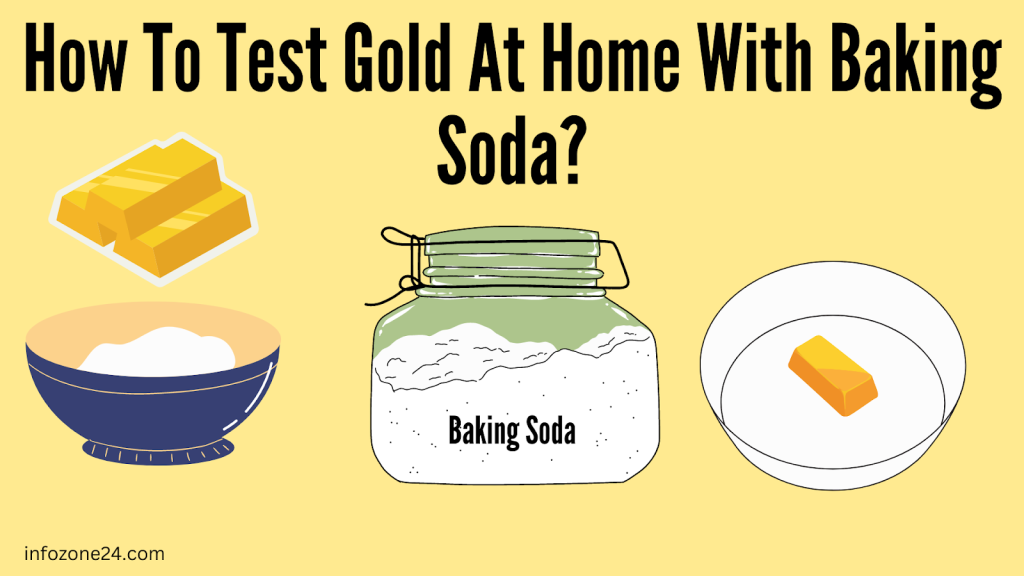Everyone is familiar with baking soda as a household ingredient. But the question is, how to test gold at home with baking soda? Baking soda is used for baking and can be found in almost every home. It can also be used to test gold. Testing gold with baking soda is a simple and accessible process. You can use baking soda to test a gold coin, bar, or jewelry.
In this article, we will explain how to test gold at home with baking soda. Additionally, we will provide some tips for the baking soda test along with its limitations.
Procedure To Test Gold At Home With Baking Soda
Testing gold with baking soda is a simple and handy method. With this test, you can determine whether your gold item is real gold or gold-plated. Here’s how to test gold at home with baking soda:
What Do You need?
- Baking Soda
- Pot Or Bowl
- Water
- The Gold Piece In Question
The Baking Soda Test
This test can be conducted in two ways. Both of the ways are given below:
Procedure #1
- Mix baking soda with water in a pot or bowl. Make a soft paste.
- Rub the paste onto a small portion of the gold in question.
- Leave the paste on your gold for at least 30 minutes.
- Rinse thoroughly under tap water.
- Make sure that you remove the baking soda completely.
- Use a clean and soft cloth to dry your gold item.
Procedure #2
- In a pot or bowl, make a solution by mixing one part of water and three parts of baking soda.
- Take your gold item and immerse it completely in the solution.
- Leave it in the solution for at least 30 minutes.
- Take it out and rinse thoroughly under tap water.
- Make sure that you remove the baking soda completely.
- Use a clean and soft cloth to dry your gold item.
Note: Procedure #1 is recommended. It is not suitable to leave your gold item in baking soda solution for this long time. If you have confirmed that it’s real gold, then you can use procedure #2 to clean real gold. Still, if your gold item has pearls or gemstones, don’t leave it in the baking soda solution.
Keep Reading: How To Check If Gold Is Real With Toothpaste
Observations
The following are the things you may notice after the test:
- Baking soda originates a chemical reaction that leads to the discoloration of counterfeit gold.
- However, if the item is gold-plated, the baking soda will react with the metal underneath and you will notice discoloration.
- Baking soda will have no effect on authentic gold.
Results
Here’s how you can draw conclusions about your observations:
- If your gold piece is authentic, nothing will happen to it. Baking soda won’t create any scratches on authentic gold. Rather, it will clean the gold and make it glistening.
- If your gold piece is fake, baking soda will react with it. You will notice discoloration and this discoloration will be permanent.
- If your gold piece is gold-plated, baking soda will remove the thin gold overlay and reveal the base metal.
Note: Baking soda damages the fake gold permanently. So, if you don’t want to get your gold piece damaged, don’t use baking soda on it.
Tips
- While rinsing your gold piece, do it over a glass bowl or a sieve. So, your gold piece doesn’t accidentally wash down the drain. You can also plug your sink to avoid this.
- Rinse your gold item thoroughly to remove the baking soda completely. Dried particles of baking soda can make a horrid film on your gold. Make sure that you dry your gold with a clean and soft cloth.
- If your gold item contains gemstones or pearls, avoid using baking soda in that area.
Keep Reading: How To Check If Gold Is Real With Water?
Why Baking Soda Test Works?
Baking soda, also known as Sodium Bicarbonate, can be used to test gold’s authenticity. It is an abrasive and alkaline compound. The alkaline substance is harsh on counterfeit gold, especially those with low-quality metals and gold-plating.
When applied to fake gold, baking soda can change its color permanently. Fake gold is usually made with zinc, silver, copper, brass, or bronze. Baking soda is harsh on all of these metals.
Gold-plated items have a thin layer of gold over a base metal. When you rub the baking soda paste on gold-plated items, it can cause deep scratches and reveal the base metal. Gold-plated items can also have a gold-like metal overlay. Either way, it will be scratched off by the baking soda.
If your gold is real, baking soda will have no effect on it. Rather, the baking soda paste will clean the gold. And also, make it shinier by removing all the dirt.
Limitations Of Baking Soda Test
Here are some limitations of the baking soda test:
- This test is not suitable for all types of gold items. Like gold dust cannot be tested by this method.
- It may not detect all types of impurities in your gold.
- Baking soda can cause some damage to the gold. That’s why it should be used on small portions of your gold item.
- As baking soda is abrasive in nature, it can permanently damage some fake gold items. It can cause scratches and discoloration permanently.
Conclusion
So, now you know how to test gold at home with baking soda. It is time to understand that this test is not foolproof. Although it is simple and easy, it should only be used as a preliminary testing method. This method is suitable to check if your item is gold-plated or it is made of solid gold. Remember that if you don’t want your jewelry to get damaged, don’t use baking soda on it.
It can permanently damage a fake gold piece. Moreover, checking gold’s authenticity with baking soda is not as accurate as other professional methods. But it can give you an idea of your gold’s authenticity. It is always a good idea to consult a professional appraiser to have your gold piece analyzed.
Keep Reading: How to Check If Gold is Real With a Lighter & 18 Other Methods
Michael C Vang is a passionate blogger. He has been blogging since 2013 on a variety of topics. He is committed to creating informative and engaging content that helps readers learn more about everything.



